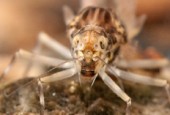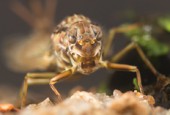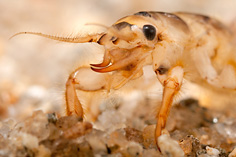Mayfly nymphs (order Ephemeroptera)
Contained families:
Heptageniidae (Flathead mayflies)
Baetidae (Minnow mayflies)
Siphlonuridae (Primitive minnow mayflies)
Potamanthidae (Hacklegill mayflies)
Leptophlebiidae (Prong-gilled mayflies)
Ephemeridae (Common burrowing mayflies)
Ephemerellidae (Spiny crawler mayfly nymph)
![]()

Flathead mayfly nymphs
(order Ephemeroptera, family Heptageniidae)
Feeding:
Nymphs scrap periphyton (layer of algae and associated fauna and flora).
Habitat:
Flathead mayfly nymphs are common in flowing waters of streams and rivers.
Movement:
These clingers are perfectly adapted to adhere to solid surface and move around the stones.
Size:
Mature nymphs can grow up to sizes around 20 mm (not including antennae and caudal filaments).
Life cycle:
Mayflies undergo incomplete metamorphosis. Their life cycle includes four stages – egg, nymph, subimago and adult (imago). Most species produce one or two generations per year.
Introduction:
All mayflies are aquatic in the nymphal stage, while adults are terrestrial. Nymphs are found in a variety of freshwater habitats including lakes, ponds, wetlands, streams and rivers. Consequently, form one of the most important food sources for fish.
Flathead nymphs are most abundant and diverse in flowing waters of streams and rivers. They occur on the surface of rocks and submerged logs, where search for food. Nymphs scrap algae and associated microorganisms by using their adapted mouthparts (labial palps possess setae, thereby forming brushes).
Heptageniid nymphs have substantially flattened bodies. Strong legs are spread to the sides and each ends with the single tarsal claw. Well developed eyes are placed on the back of the flattened head. These adaptations, reducing drag of the current, make the nymphs perfectly adapted to live in flowing waters. They are able to maintain and move even in the fastest sections of mountain streams.
When disturbed, nymphs quickly hide themselves under the stones. This is known behavior of fish turning the stones, in order to find the nymphs.
Abdominal segments possess gills in the form of thin discs. Gills are rounded or leaf-like in shape and may be supplemented with tufts of filaments at the base. Position and shape of the gills are important identification features among the species.
The body of mayfly nymphs terminates in three distinct caudal filaments. Flathead nymphs have these filaments long and covered with very short setae.
Presence of flathead nymphs is often an indicator of good water quality, because they are relatively intolerant to pollution.
Gallery:

Minnow mayfly nymphs
(order Ephemeroptera, family Baetidae)
Feeding:
Collectors/scrapers feeding on algae and detritus.
Habitat:
Baetid nymphs live in almost all types of freshwater habitats.
Movement:
Swimmers/clingers.
Size:
Mature nymphs can grow up to sizes around 12 mm (not including antennae and caudal filaments).
Life cycle:
Mayflies undergo incomplete metamorphosis. Their life cycle includes four stages – egg, nymph, subimago and adult (imago). Most species produce one or two generations per year.
Introduction:
Baetid nymphs, of a tightening streamlined body shape, are very skilled swimmers (hence the name Minnow mayflies).
They have a rounded head bearing a pair of antennae, which are at least two or three times longer than the width of the head. Rapidly oscillating plated gills are usually oval or leaf-shaped and placed on the sides of the abdomen. Body terminates with three long hairy filaments. By synchronizing the movements of these body parts can quickly escape the predators.
Baetid nymphs are widespread and can be found in a variety of freshwater habitats. If conditions permit, they occur in large numbers. Some species can be very common in polluted and low oxygenated waters. Moreover, they are tolerant to temperature fluctuations and can overwinter as active and growing nymphs.
Baetid nymphs feed on plant matter, algae and organic debris, which they scrap from solid surfaces or collect from the sediments.
Brownish or greenish colour, along with partial translucency, makes them well camouflaged in tangles of plants and roots.
Lifespan of adult mayflies ranges from several hours up to two days. Depends on the species and an ambient temperature plays a role too. The adult lifespan is so short, that there is no need for the insects to feed. Therefore the adult mayflies lack functional mouthparts and digestive tract.
The majority of life is lived out in the nymphal stage. The nymphs of some species are evolving up to several years, to give the basis for future generations within a very short time. In the same way as we would like to settle up all the adult matters in the last month of our human life.
Gallery:
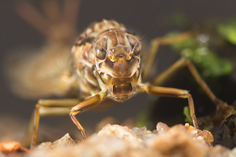
Primitive minnow mayfly nymphs
(order Ephemeroptera, family Siphlonuridae)
Nymphs of the family Siphlonuridae are robust, olive brown animals, up to 18 mm body length. They inhabiting lakes, ponds, rivers and streams. Characteristic features of the nymphs are well developed lateral spines on abdominal segments, abdominal segments bear dark marks, large leaf-like tracheal gills and short antennae which are shorter than twice the width of the head. Nymphs are good swimmers and typically swim in short, fast thrusts. They feed by gathering or collecting fine detritus from the sediments. Most species produce one generation per year and overwinter as eggs.
Primitive minnow mayflies (Siphlonuridae) are closely related to Minnow mayflies (Baetidae), which are described above.
Gallery:
Summer mayfly (Siphlonurus lacustris) emerging:
 Hacklegill mayfly nymphs
Hacklegill mayfly nymphs
(order Ephemeroptera, family Potamanthidae)
Feeding:
Collectors/gatherers feeding on algae and detritus.
Habitat:
Nymphs live in flowing waters of streams and rivers.
Movement:
They cling on stones and submerged wood. Young nymphs burrow in soft sediments.
Size:
Mature nymphs can grow up to sizes around 15 mm (not including antennae and caudal filaments).
Life cycle:
Mayflies undergo incomplete metamorphosis. Their life cycle includes four stages – egg, nymph, subimago and adult (imago). Most species produce one generation per year.
Other characteristics:
short mandibular tusks; short antennae; slender legs (not adapted for burrowing); branched and fringed gills increase the surface area to extract oxygen from the water
Gallery:
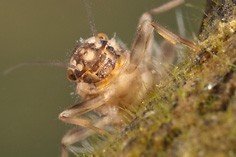 Prong-gilled mayfly nymphs
Prong-gilled mayfly nymphs
(order Ephemeroptera, family Leptophlebiidae)
Feeding:
Collectors/scrapers feeding on algae and detritus.
Habitat:
Nymphs live in flowing waters of streams and rivers, in locations of moderate current.
Movement:
Crawlers/clingers – they are found on stones, submerged logs or leaf packs. Before emerging, the nymphs migrate in large numbers upstream to compensate the drifting.
Size:
Mature nymphs can grow up to sizes around 15 mm (not including antennae and caudal filaments).
Life cycle:
Mayflies undergo incomplete metamorphosis. Their life cycle includes four stages – egg, nymph, subimago and adult (imago). Most species produce one or two generations per year.
Other characteristics:
flattened body and head; forked and slender gills on the sides of abdominal segments; short setae on caudal filaments
Gallery:
 Common burrowing mayfly nymphs
Common burrowing mayfly nymphs
(order Ephemeroptera, family Ephemeridae)
Feeding:
Collectors/gatherers – burrowing mayfly nymphs feed on organic particles dispersed in sediments.
Habitat:
Nymphs can be found in a variety of ecosystems from small ponds and streams to large lakes and rivers.
Movement:
They spend most of the nymphal stage burrowed in sand or mud at the bottom.
Size:
Mature nymphs can grow up to sizes around 35 mm (not including antennae and caudal filaments).
Life cycle:
Mayflies undergo incomplete metamorphosis. Their life cycle includes four stages – egg, nymph, subimago and adult (imago). Most species produce one generation per year.
Introduction:
Burrowing mayfly nymphs are found in the soft silt or sand at the bottom of both running and still waters.
Ephemerid nymphs may occur in large numbers, representing a significant portion of overall bottom biomass. If conditions in the habitat permit, nymphs can be found even at great depths.
Nymphs have a long cylindrical body of yellowish colour supplemented with dark patterns. The head is equipped with upturned mandibular tusks and frontal processes between antennae. Strong legs are widened for digging in sediments. Forked gills with fringed margins are held over the top of abdomen.
Common burrowing mayfly nymphs build tunnels in soft sediments. These burrows are U-shaped with both ends opened. Nymphs create a current of water through retreats by moving their feather-like gills. Current brings oxygenated water to breathe and detritus to feed on.
When the night comes, nymphs leave their burrows to look for more food, or in order to shed old nymphal skins. In contrast to their secretive habits, nymphs can swim surprisingly swiftly by undulating their bodies.
Emergence of individual species is highly synchronized. All members of one generation fly out within one or two days.
When emerge from the last nymphal skin, mayflies enter the stage called subimago, which is unique among other insects. They have functional wings but reproductive system is not fully developed in this stage. It usually takes few hours up to one day, until subimago molts again and takes off as an adult (imago).
Gallery:
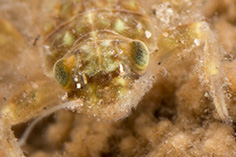 Spiny crawler mayfly nymphs
Spiny crawler mayfly nymphs
(order Ephemeroptera, family Ephemerellidae)
Gallery:


